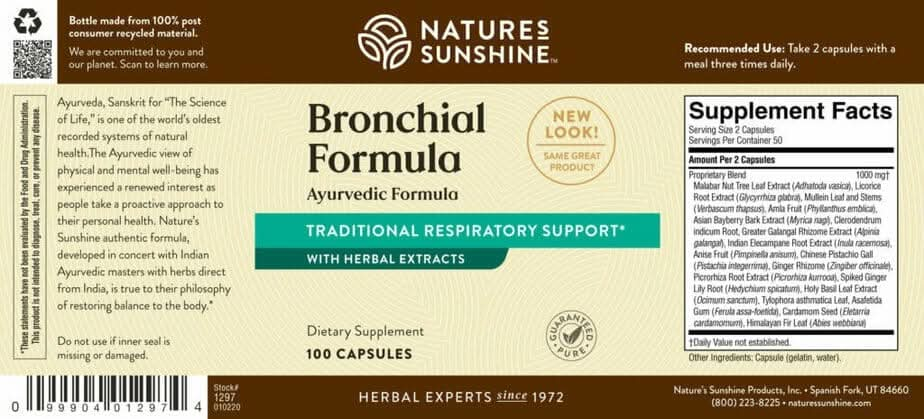The Herbs Place
Bronchial Formula
Bronchial Formula
Couldn't load pickup availability
When it comes to bronchial and other respiratory problems, a holistic approach using Ayurvedic herbs is a new avenue to take and get optimum results. The Ayurvedic approach to disease, similar to Chinese and other natural health philosophies, focuses on looking at associated body systems that may be the real root of the health problem
In this case, the digestive system is most often the cause of congestion in the sinuses, throat, bronchioles and lungs. Therefore, treating the congestion means improving digestion, not just strengthening the mucous membranes protecting sensitive tissues. Improperly digested food is the most common cause of this type of health problem, especially in children whose enzyme production may not be developed yet.
Although Western equivalents (like ALJ and Sinus Support-EF) are available to treat these health problems, Ayurvedic Bronchial Formula, a special combination of herbs from the East will help many who find Western formulas either too slow or not quite right for their particular needs. With thousands of years of experience, Ayurvedic herbalists offer some amazing possibilities to Western man. Below are just some of the benefits possible with Ayurvedic Bronchial Formula as shown by the ingredients listed:
Adhatoda vasica is well known in Ayurvedic medicine for its effects on bronchitis and asthma cases. Several alkaloids in its leaves produce dilation of the bronchial tubes in laboratory experiments.
Alpina galanga is popularly known in India as "Catarrh Root" and Galangal. This herb has a pleasant aroma, and the rhizome is used for both rheumatism and catarrhal problems. Alpina galanga is an aromatic, stimulant, stomachic and cordial (helping the heart).
Clerodendrum indicum root extract is used for various lung ailments, cough, asthma and scrofula (tuberculosis).
Glycyrrhiza glabra is well known to us as licorice root and helps combat inflammation, encourages good digestion and feeds the adrenal glands to combat stress. Glycyrrhetic acid is anti-bacterial, and Chinese herbalists also use it for chronic bronchitis.
Hedychium spicatum root and rhizome are rich in essential oil and are used for fever, rhinitis (runny nose) and swelling.
Inula racemosa is considered one of the best rejuvenative tonics for the lungs. This herb helps to reduce liquid in the lungs and strengthen muscles for better breathing capacity. Inula racemosa also reduces swelling and is one of the best expectorants and cough relievers.
Myrica nagi stembark is a detoxifier also used for wounds and ulcers due to its high tannin content.
Ocimum sanctum leaves are used for both fever and asthma symptoms. This member of the basil family has also shown anti-bacterial and anti-fungal properties.
Phyllanthus emblica fruit (also called "White Galls") is cooling and is used to treat inflammation and digestive troubles, both of which commonly occur in people with respiratory problems. Moreover, the sour, dried fruit is used for hemorrhaging and is also called "Myrobalans."
Picrorhiza kurroa root contains kukin and picrorhizin, bitters that help the liver, which in many cases helps to treat asthma cases. This root also improves blood circulation.
Pimpinella anisum is especially useful in improving digestive powers, which in turn diminishes blood allergens that may cause respiratory congestion and asthma. This plant, best known to Western man as anise, is a stimulant and tonic for the body.
Pistacia integerrima gall is used as an astringent to help alleviate coughs and edema in the lungs.
Sida cordifolia is a diuretic and anti-inflammatory that helps relieve swelling.
Zingiber officinale, whose common name is ginger, has been called the "universal medicine" in India. In Asia this root has been used for thousands of years for indigestion, bleeding and chest congestion.
Sources
Chinese Herbs by John D. Keys (Rutland, Vermont: Charles E. Tuttle Co., 1976). Medicinal Plants of China by James A. Duke (Algonac, Michigan: Reference Publishing, Inc., 1985). CRC Handbook of Ayurvedic Medicinal Plants by L. D. Kapoor (Boca Raton, Florida: CRC Press, 1990).
For Educational Purposes Only - The above information was prepared by Nature's Field P.O. Box 425, Springville, UT 84663 It may be copied and distributed provided it is not altered in any way.
Customer Comments
"My daughter asked me to try herbs for my respiratory weakness. I didn't have any energy trying to breathe all the time. I bought Ayurvedic Bronchial Formula and it has done an excellent job. I'm able to breathe and go again." Customer "My mother was diagnosed with chronic respiratory weakness and for the past two or three winters she has had to enter the emergency room for breathing treatments for a few hours. I started giving her (NSP) Ayurvedic Bronchial Formula the summer of 1998, so therefore, when winter came her respiratory system was improved. First, I am thankful to God, then to Donna, who told me about the formula. My husband takes it too and it is wonderful!" P.C. Wilson
Recommended Use
Take two capsules with a meal three times daily.
Ingredients per Capsule
Proprietary blend 521 mg of:
Verbascum thapsus Leaf
Adhatoda vasica Leaf Extract
Glycyrrhiza glabra Root Extract
Alpinia galanga Rhizome Extract
Clerodendrum indicum Root
Inula racemosa Root Extract
Myrica nagi Bark Extract
Phyllanthus emblica Fruit
Hedychium spicatum Root
Picrorhiza kurroa Root Extract
Pimpinella anisum Fruit
Pistacia integerrima Gall
Zingiber officinale Rhizome
Ocimum sanctum Leaf Extract
Tylophora asthmatica Leaf
Abies webbina Leaf
Elettaria cardamomum Seed
Ferula assafoetida Gum




